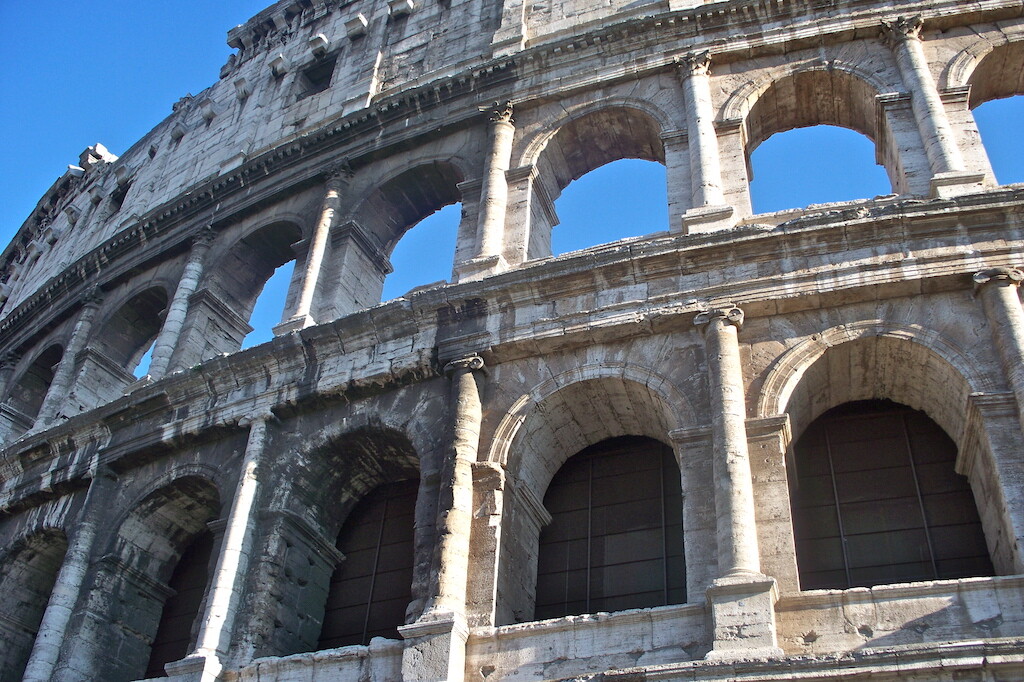 |
The outer structure of the Flavian Amphitheater in Pozzuoli. Parts of the original Pozzolana are still visible.
|
Roman
Concrete
Concrete
How Volcanic Material
Created An Empire
written by Jim H
Roman
concrete is a remarkable innovation that served as the building blocks for the
world’s most impressive megastructures.
In
Italy, the Colosseum, Pantheon, and Flavian amphitheaters of Pozzuoli and Capua
are just a few unparalleled examples of what this special concrete has built.
It
derives from a certain type of volcanic ash and was made with ancient knowledge
that has since been lost.
Utilizing
this incredible natural material, the Romans constructed the strongest, most
beautiful, and longest-lasting architecture of all time.
Why
was Roman concrete so special, and how did it impact the Roman Empire?
What
is Roman Concrete?
Roman
concrete derives from a type of volcanic ash called Pozzolana.
Unlike
other types of volcanic material, Pozzolana contains siliceous (silicon
dioxide) and aluminous elements. This unique composition makes the ash react
with other materials.
Under
the right conditions, this ash will bond with specific elements to create a
type of cement. It is this cement that became the backbone of Roman
civilization.
While
volcanic materials are prevalent in many areas, Pozzolana is mainly from the
area of Pozzuoli in the region of Naples, Italy. Hence, the name of the
material derives from its place of origin.
Ancient
Greeks were probably the first to use volcanic material to generate concrete.
And interestingly, it was the Greeks who actually founded the areas of Pozzuoli
and Naples.
These
areas are highly volcanic with the well-known Mt. Vesuvius just across the Bay
of Naples and the super volcano, Campi Flegrei, around the region of Pozzuoli.
Many
eruptions in the area have produced copious amounts of volcanic tuff (ash that
has hardened into stone) or tufo in Italian, which decomposes into Pozzolana.
Thus,
early builders of Rome would travel long distances to Pozzuoli to acquire the
special Pozzolana.
Evidence
exists from Kameiros, Rhodes, which indicates ancient Greeks were already using
volcanic ash for cement in 500-400 BC.
However,
the Romans refined the process of using Pozzolana by creating lime-based pastes
to bind structures together.
With
this process, Pozzolana could be used to create sturdy buildings in addition to
advanced underwater footings, due to its ability to harden underwater.
How
Romans Made Their Cement
Because
of its widespread usage throughout the empire, it is no surprise that they
thoroughly documented the production of Roman concrete.
One
of the most reliable sources regarding the use of Pozzolana is from Vitruvius,
who wrote about four distinct variations.
He
distinguished the variations by color and areas in which the Romans could find
the ash throughout Italy.
The
concrete mixing process became fairly standardized throughout the Roman world.
According to historic records, their blend consisted of three ingredients.
In
addition to the Pozzolana, the Romans also added a lime paste and small rocks.
This is similar to the way builders make cement today.
However,
the unique chemical composition of Pozzolana made Roman concrete unusually
strong, even in comparison to modern blends.
Impacts
of Roman Concrete
This
strength, combined with the fact that it could harden under water contributed
to the rise of the Roman empire.
Because
Pozzolana expanded construction to include seaports and other waterways, the
Romans were able to anchor themselves along the coastlines of their empire.
This
not only allowed them to have a strong naval presence, but it also opened the
channels for maritime trade, which brought in vast amounts of wealth.
One
of the best examples of coastal construction using Roman concrete is at
Caesarea Maritima. Today, Caesarea Maritima is an Israeli national park.
Initially,
these ruins were part of a port that the Romans constructed under the rule of
Herod the Great.
Although
it is no longer a center of commerce as it once was, many of the structures are
still visible. This includes an aqueduct and a theater.
Most
impressively, parts of the construction are visible underwater in the shallow
zone with minimal erosion or damage.
Another
good example of the longevity of Roman concrete exists at Cosa.
In
this area of southwestern Tuscany, Romans laid the piers underwater by using
long tubes. This allowed the concrete to set without seawater getting into the
mix.
Although
the area has degraded through time, the three piers still stand. Amazingly, the
underwater portions are in remarkably good condition.
A
Lasting Roman Legacy
Many
factors helped the Romans achieve great societal success.
However,
one of the most important was arguably their ability to build magnificent
architecture and lasting infrastructure.
Numerous
structures still stand in testimony to the building materials and skills of the
Romans.
In
fact, at one time, it was said that “all roads lead to Rome,” and one of those
roads that still exist today, Via Appia, led directly to Naples.
This
is the breathtaking place where the elite would vacation lavishly at their
seaside villas and where Roman builders acquired their Pozzolana – the same
material that built their society.
Unfortunately,
much of the ancient knowledge and skill of using Roman concrete died along with
the Roman Empire.
However,
modern builders still find uses for Pozzolana as our society seeks to build its
own lasting legacy for the centuries to come.
Jim has always had a strong
passion for travel, archaeology, and history. He feels fortunate to have been
able to visit many of the ancient wonders that he read about in history books.
As the founder of Historic Mysteries, his goal is to share with you the secrets
of our past.
 |
| Caesarea is the earliest known large scale example of underwater Roman concrete. |


No comments:
Post a Comment